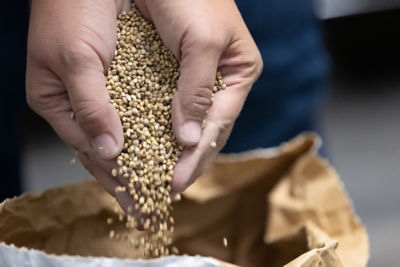Click here to download a PDF version of this spotlight.
» Vegetable production in high tunnels requires attention to soil health issues.
» Soil pH, salinity, organic matter levels, and soilborne diseases are important issues in high tunnel vegetable systems.
High tunnels are complex systems that require adaptive processes for managing and maintaining productive, healthy soils.1 “Soil health is defined as the continued capacity of soil to function as a vital living ecosystem that sustains plants, animals, and humans.”2 Soil health is affected by chemical, physical, and biological aspects of the environment.3 The conditions within high tunnels have been described as “irrigated deserts”, as they tend to be hot, lack a natural source of moisture, and their environment is not actively controlled (Figure 1).4 Production intensity is usually higher, with longer seasons but shorter rotations of cash crops. These factors can result in issues with soil nutrients, pH, salinity, organic matter, and pathogen populations that can affect soil health.1,3,4
 Figure 1. Vegetables growing in a high tunnel system. Nicole Gauthier, University of Kentucky.
Figure 1. Vegetables growing in a high tunnel system. Nicole Gauthier, University of Kentucky.
SOIL NUTRIENTS
Extended growing seasons result in a greater need for nutrients by crops, but there can also be a nutrient buildup in high tunnel soils because of over-application or failure to account for nutrients from various inputs, such as organic matter or irrigation water.5 In particular, nitrogen (N), phosphorus (P), and calcium (Ca) levels in high tunnel soils are often above what is needed by the crops. Fertilizers applied to areas outside of the drip irrigation zone may not be solubilized with regular irrigations and build up over time, and manure applied to these areas may not receive enough moisture to allow microbial breakdown.1,3 Elevated soil salinity levels can also interfere with the uptake of nutrients by plants.4
Test soils for nutrient levels at least annually, testing at the same time each year. Avoid applying fertilizers containing P and Ca if levels of those nutrients are high. Test soil amendments for nutrient content before application.5
SOIL PH
For most vegetables, optimal nutrient availability occurs at pH levels between 6.0 and 7.0 in mineral soils and between 5.3 and 5.8 in organic soils.6,7 However, with the lack of natural rainfall and the use of higher pH irrigation water, soil pH in high tunnel systems tends to increase over time. Soil pH levels above 7.0 can result in reduced availability of some nutrients, especially iron, zinc, and manganese.1,6 The repeated application of irrigation water with high alkalinity can also result in an increase in soil pH over time. Alkalinity levels of irrigation water should be between 0 and 100 ppm CaCo3.7
Keep soil pH records and initiate mitigation if levels are above 6.5. If the soil pH is too high, acidify the soil with applications of elemental sulfur. Regularly test the pH and alkalinity of irrigation water. If the water’s pH is too high, acidify it to lower the level. Check the pH of soil amendments, such as composts and manure. Ammonium and urea-based N fertilizers can help decrease soil pH, while nitrate N can increase it.5,7
SALINITY
High tunnel soils can accumulate salts as a result of the regular use of high-salt fertilizers, composts and manures, and the absence of natural rainfall.3,8 Salts in irrigation water are also left in the soil when water evaporates or is taken up by plants. Increased salt levels can reduce water uptake, stunt plant growth, and result in the death of seedlings and mature plants.2,8 Soluble salts, including sodium (Na), potassium (K), calcium (Ca), magnesium (Mg), chlorine (Cl), and nitrate (NO3), are also introduced with the application of mineral fertilizers. Nutrients not taken up by the plants may remain in the root zone if they are not leached through the soil profile.9
To help attain peak production, regularly monitor soil salt levels. Help reduce salt accumulation by locating tunnels in areas with good soil drainage. Avoid the over-application of fertilizers and use soil test results to determine application rates. Select low-salt fertilizers, and limit the use of animal manures if salt levels are becoming problematic. Irrigate with water containing low salt levels. If high salt levels develop, choose crops and varieties that have some salt tolerance.10
Accumulated salt can be leached from the soil with rain or abundant overhead irrigation. When it needs to be replaced, leaving the plastic off of the tunnel for several months can allow natural precipitation to flush salts from the system. Six inches of water will flush about 50%, twelve inches about 80%, and twenty four inches about 90% of the salt from the root zone. If salt levels start to inhibit plant growth and production, consider moving the tunnel to a new location if possible.1,3,4,9,10
SOIL ORGANIC MATTER
There are many benefits to adding organic matter to soil. Higher organic matter levels help increase water holding capacity, enhance the cation exchange capacity, and improve the physical structure of the soil.1 In high tunnel systems, higher temperatures may result in soil organic matter decomposing more quickly, and it may need to be replenished more often. In some situations, the organic matter outside of the drip irrigation zone may decompose more slowly because of the lack of moisture.1,4,5 The salt and nutrient content of organic matter amendments need to be evaluated and taken into account when addressing issues of soil pH, salinity, and nutrient balance. The optimal carbon-to-nitrogen ratio (C:N ratio) is 30:1. Lower rates can result in the loss of N as ammonia gas, while organic matter with higher rates may not contain the amount of N needed to sustain microbial decomposition of the material. It is usually best to apply organic amendments in the spring when warmer temperatures can help promote microbial activity and decomposition.3,5,7
Cover crops can be used to add organic matter to soils in high tunnel systems, but the higher cropping intensity and longer growing seasons can make it more difficult to include cover crops in the rotation. Legume cover crops can supply N without increasing soil salinity. Some concerns with using cover crops include reduced time for crop production, overwintering of cover crops in northern areas, the amount of biomass generated, and the timing and methods used to terminate the cover crop. The importance of these issues will vary with the region, whether the system is organic or conventional, cover crop species are used, and what cash crops are grown.1,3
SOILBORNE PATHOGENS
Many foliar plant diseases are less problematic on vegetables in high tunnel systems because of less free moisture on the leaves due to the lack of rain and splashing water when drip irrigation is used.11 However, soilborne diseases can still be an important issue. Diseases caused by soilborne pathogens such as Fusarium, Verticillium, Rhizoctonia, Sclerotinia, Phytophthora, Pythium, Ralstonia, and Meloidogyne can result in substantial yield reductions and economic losses on vegetable crops in high tunnel systems.12,13 Soilborne diseases are difficult to manage once established, and there can be constraints on some management options in high tunnel systems.
Excluding pathogens to prevent their establishment is a priority. Use certified disease-free seeds and transplants when possible. Inspect seedlings for disease symptoms before transplanting. Remove plant debris during the season and after the final harvest. Rogue out diseased plants and fruit to remove inoculum and limit spread. Clean tools and equipment frequently. Limit movement of tools and personnel between disease- and disease-free areas. Eliminate weed hosts and volunteer plants that can serve as sources of inoculum.11,13
Promote soil conditions that suppress disease development. Provide good soil drainage with drainage tiles or raised beds to limit water molds and other root rot pathogens. Avoid over-irrigating and follow an appropriate irrigation schedule. Use only pathogen-free sources of irrigation water. Increasing the soil pH can help suppress diseases such as club root of brassicas and bacterial wilt of tomatoes. Rotate sections of the tunnel between crop families (brassicas, cucurbits, solanaceous crops) to minimize pathogen buildup in the soil. Rotations of at least three years are recommended. Only use fungicides that are labeled for use in greenhouse systems.Soil fumigants may be needed if pathogen populations get too high to manage with other methods. Use soil solarization and biocontrol agents, including biofumigants, to manage disease development and pathogen populations.11,12,13
Installing movable tunnels can help with the management of salinity and soilborne pathogen buildup by allowing the tunnel to be moved to a new site periodically.1
SOURCES
1 Grossman, J. and Jacobsen, K. 2016. Soil health in high tunnel production. https://forestrywebinars.net/webinars/soil-health-in-high-tunnel-production/.
2 Soil health. Natural Resources Conservation Service. https://www.nrcs.usda.gov/conservation-basics/natural-resource-concerns/soils/soil-health
3 Lent, C. 2024. High tunnel soil management for season extension. NCAT AATRA. https://attra.ncat.org/high-tunnel-soil-management-for-season-extension/.
4 Grossman, J. Connecting high tunnels to soil health. University of Minnesota. https://bwsr.state.mn.us/sites/default/files/2021-09/High%20Tunnel_Soil%20Health_Presentation.pdf
5 Reid. J. 2018. High tunnel best management practices: Long term soil health and fertility. Cornell Cooperative Extension. https://rvpadmin.cce.cornell.edu/uploads/doc_652.pdf.
6 Sánchez, E. and Ford, T. 2023. High tunnel soil test report: soil pH. Penn State Extension. https://extension.psu.edu/high-tunnel-soil-test-report-soil-ph.
7 Langenhoven, P. 2024. High tunnel soil fertility management: What you need to know. Purdue Vegetable Crops Hotline, Issue 733.
8 Carpenter, J., and Lewis, J. 2021. Salinity management in high tunnel systems. West Virginia Extension. https://extension.wvu.edu/natural-resources/soil-water/salinity-management-in-high-tunnelsystems.
9 Rudolph, R., Lark, R., and Jacobsen, K. 2022. Soil salinity in high tunnel production. University of Kentucky, Center for Crop Diversification Fact Sheet CCD-FS-24.
10 Sánchez, E. 2023. Dealing with high soluble salt levels in high tunnels. Penn State Extension. https://extension.psu.edu/dealing-with-high-soluble-salt-levels-in-high-tunnels.
11 Sikora, E., Conner, K., Bloodworth, M., Kemble, J., and Majumdar, A. 2018. Disease management in high tunnel systems. Alabama A&M and Auburn Universities Extension. https://www.aces.edu/blog/topics/farming/disease-management-in-high-tunnel-systems/.
12 Baysal-Gurel, F., McSpadden Gardener, B., and Miller, S. 2012. Soilborne disease management in organic vegetable production. https://eorganic.org/node/7581.
13 Gauthier, N. 2023. Beginner disease management for vegetable production. Kentucky Vegetable Crops Extension and Research. https://www.youtube.com/watch?v=LY8sa5yCdAw.
Websites verified 4/11/2024
ADDITIONAL INFORMATION
For additional agronomic information, please contact your local seed representative.
Performance may vary, from location to location and from year to year, as local growing, soil and environmental conditions may vary. Growers should evaluate data from multiple locations and years whenever possible and should consider the impacts of these conditions on their growing environment. The recommendations in this article are based upon information obtained from the cited sources and should be used as a quick reference for information about vegetable production. The content of this article should not be substituted for the professional opinion of a producer, grower, agronomist, pathologist and similar professional dealing with vegetable crops.
BAYER GROUP DOES NOT WARRANT THE ACCURACY OF ANY INFORMATION OR TECHNICAL ADVICE PROVIDED HEREIN AND DISCLAIMS ALL LIABILITY FOR ANY CLAIM INVOLVING SUCH INFORMATION OR ADVICE.
5017_393183 Published 05/13/2024




